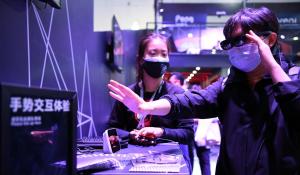East China’s Jiangxi Province will host an upcoming spotlight event “2022 World Conference on the Virtual Reality (VR) Industry “ in November in its provincial capital, Nanchang.
Jiangxi, traditionally known for porcelain-making, commerce, and manufacturing, is becoming a growth driver for the digital economy as leading firms, specialists, and innovation resources have gravitated to this land in eastern China.
Themed “VR Adorns the World, VR Brightens the Metaverse,” the event launches two new summits this year featuring metaverse and industrial and supply chains separately.
In addition, six innovative application scenarios will be put into place, including a metaverse venue, virtual host "Jiang Xiaowei", augmented-reality live navigation, an opening speech with special effects and VR live broadcast, for online and offline participants to explore an immersive experience.
Since the event was first initiated in 2018, Jiangxi has seen a boom in the VR industry. The aggregate operating revenue of local VR and related industries rocketed from 4.2 billion yuan (around 583 million US dollars) to 60.4 billion yuan (about 8.38 billion US dollars) in 2021. The figure reached 35 billion yuan (about 486 million US dollars) in the first half of this year, up more than 30 percent year-on-year, and is expected to exceed 80 billion yuan (about 11.1 US dollars) in 2022. (https://www.sohu.com/a/595195143_120569501)
The province now hosts more than 400 VR firms, including industrial giants Huawei, Alibaba, Tencent, Microsoft, Qualcomm, Ziguang, and Hikvision.
Official figures showed that 18 of the country’s top 50 VR firms have settled in Jiangxi. With many VR Hardware manufacturers swarming in, a complete industrial chain has taken shape, making it much easier for upstream and downstream firms to seek synergy in business development and innovation.
Apart from the annual conference, institutional arrangements and policy support also serve as the big catalyst for the province’s VR boom.
For instance, Jiangxi has rolled out China’s first provincial-level measures to facilitate VR industry development and boost VR applications. Follow-up policy support were rapidly made by the provincial capital and relevant economic development zones and high-tech zones so as to better tackle the needs of businesses on the ground.
To foster a sound ecology for VR firms to thrive and flourish, Jiangxi has selected and released provincial-level VR application demonstration projects for two consecutive years, and organized roadshows for VR application projects.
There are more than 30 industry-university-research platforms there, including Huawei Nanchang Research Institute, Microsoft AI+VR Innovation Base, and Qualcomm Film Creation Joint Innovation.
The province also sought to expand cooperation with the Guangdong-Hong Kong-Macao Greater Bay Area and unleash its appeal and potential by boosting exchanges and opening up.
More stimulus is expected to be in the pipeline after China’s governing party concluded its national congress last month, with a chartered a road map for future prosperity.
By 2026, the total scale of China’s virtual reality industry, including related hardware, software, and applications, will exceed 350 billion yuan (about $48.56 billion), according to an official plan released by the Ministry of Industry and Information Technology.
Jiangxi, an emerging powerhouse for China’s VR industry, saw 35 percent of its provincial gross domestic product come from the digital economy in 2021.




